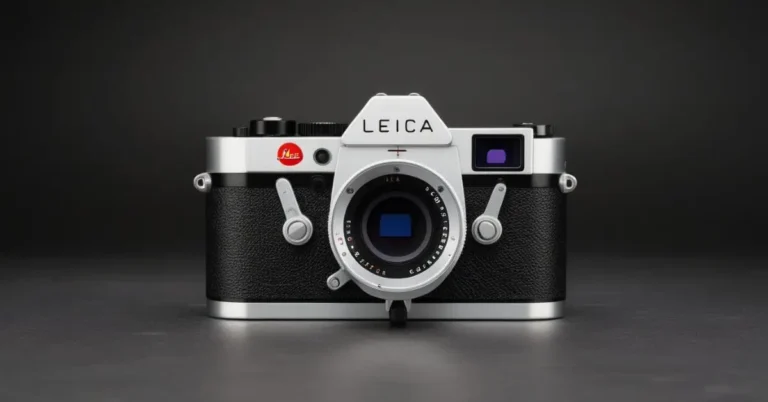The Leica Leicaflex SL2 holds a special place in the history of photography. Launched in 1974, this camera was the final iteration of the Leicaflex series, representing the pinnacle of mechanical precision and optical excellence from Leica before the company transitioned into electronic SLRs. This camera, often hailed as a masterpiece of German engineering, was a reflection of Leica’s commitment to craftsmanship and performance, designed for the discerning photographer who demanded the best. Over time, the Leicaflex SL2 has become a beloved classic, not only for collectors but also for photographers who appreciate its unmatched build quality and precision.
In this article, we’ll explore the legacy, technical features, and lasting impact of the Leica Leicaflex SL2, as well as its place in modern photography.
History of the Leica Leicaflex Series
Leica, traditionally known for its rangefinder cameras, made its first venture into single-lens reflex (SLR) cameras with the introduction of the Leicaflex in 1964. This was Leica’s response to the growing popularity of SLR cameras, which allowed photographers to preview the exact image they would capture through the lens, a feature not possible with rangefinders. The original Leicaflex, while revolutionary, was limited in some respects, especially compared to competitors like Nikon and Canon, which were already producing more feature-rich SLRs.
In 1968, Leica improved upon the original Leicaflex with the release of the Leicaflex SL. This model featured a more advanced metering system and better handling but still lacked some of the modern conveniences that were becoming standard in SLRs at the time. The Leicaflex SL2, released in 1974, was the final model in the series and incorporated several key improvements, making it one of the most sophisticated and well-built mechanical SLRs of its time.
Build Quality and Design
One of the most remarkable aspects of the Leica Leicaflex SL2 is its build quality. The camera is crafted with a robust, all-metal body that feels solid and durable in the hands of the user. Leica was known for its precision engineering, and the Leicaflex SL2 is no exception. Every part of the camera, from the dials to the shutter mechanism, operates with smoothness and accuracy that was unmatched by most competitors of the era.
At 900 grams, the SL2 is relatively heavy compared to modern cameras, but this weight contributes to its reputation as a rugged and reliable tool. It was designed to withstand the rigors of professional use in challenging conditions. In fact, it’s often said that the Leicaflex SL2 could serve as a weapon in a pinch because of its heft and durability. Leica ensured that the SL2 was a camera built to last, and many models still function perfectly today, several decades after their release.
The overall aesthetic of the Leicaflex SL2 is minimalist and functional. Leica has never been a company that focused on flashy designs, and the SL2’s exterior reflects this philosophy. Its clean lines, black and chrome finish, and minimal branding give it a timeless look that remains appealing to this day.
Optical Excellence
Leica has long been synonymous with optical excellence, and the Leicaflex SL2 was designed to work seamlessly with Leica’s extensive lineup of R-series lenses. These lenses, revered for their sharpness, color accuracy, and overall image quality, were a significant part of what made the Leicaflex SL2 such a desirable camera for professional photographers.
One of the key improvements in the SL2 over its predecessor, the Leicaflex SL, was the introduction of a more sophisticated metering system. The SL2 featured a selective through-the-lens (TTL) metering system, which allowed photographers to accurately measure light directly through the lens, improving exposure accuracy. This was a significant improvement over the earlier Leicaflex models, which had more basic metering systems.
The SL2’s viewfinder was another standout feature. It was bright and clear, with excellent focusing aids that made it easy for photographers to achieve precise focus, even in low-light conditions. This was especially important for professional photographers who needed to ensure their images were sharp and correctly exposed in a wide range of environments.
Mechanical Precision
What truly sets the Leica Leicaflex SL2 apart from many other cameras of its era is its purely mechanical operation. The camera’s shutter is a precision mechanical device, with speeds ranging from 1 second to 1/2000th of a second, as well as a Bulb mode for long exposures. The shutter release action is smooth and responsive, offering photographers a tactile connection to the image-making process that is often lost with more modern, electronically controlled cameras.
The lack of electronic components in the SL2 means that it is immune to many of the problems that can plague modern cameras, such as battery failure or malfunctioning circuitry. This has helped the Leicaflex SL2 remain operational for decades, with many photographers still using their SL2 cameras today.
In fact, the Leicaflex SL2 is often regarded as one of the most reliable cameras ever made. Its mechanical precision, combined with its durable construction, has made it a favorite among photographers who value reliability and craftsmanship above all else.
Leica R-Series Lenses and Compatibility
The Leica Leicaflex SL2 was compatible with Leica’s R-series lenses, which were renowned for their optical performance. These lenses were produced to the highest standards of precision, with hand-polished glass elements and superb coatings that minimized flare and chromatic aberrations. Leica lenses have long been celebrated for their outstanding clarity, color rendition, and contrast, and the R-series lenses were no exception.
Many photographers who used the Leicaflex SL2 paired it with iconic lenses such as the Summicron-R 50mm f/2, the Elmarit-R 90mm f/2.8, or the Vario-Elmar-R 35-70mm f/3.5. These lenses delivered outstanding image quality and helped solidify the SL2’s reputation as a camera for serious photographers who demanded the best from their equipment.
While the Leicaflex SL2 was eventually phased out and replaced by the Leica R3 (which introduced more electronic features), the R-series lenses remained compatible with many of Leica’s future SLR models. This lens compatibility has been a significant factor in the enduring appeal of the Leicaflex SL2 among photographers who appreciate the versatility and optical performance of Leica’s glass.
The End of an Era: The Transition to Electronics
The Leica Leicaflex SL2 marked the end of an era for Leica as the company moved away from purely mechanical SLRs toward more electronically controlled models. The introduction of the Leica R3 in 1976 brought electronic features such as aperture-priority automatic exposure, signaling a shift in Leica’s approach to camera design. While the R3 and subsequent models were well-regarded, they lacked some of the tactile, mechanical qualities that had endeared the Leicaflex series to photographers.
The SL2, in many ways, represents the pinnacle of Leica’s mechanical SLR design. It was the last fully mechanical SLR produced by the company, and its build quality, precision, and optical performance have made it a legend in the world of photography.
The Leica Leicaflex SL2 in Today’s Photography Landscape
Today, the Leica Leicaflex SL2 is highly sought after by collectors and photography enthusiasts alike. Its rarity, combined with its reputation for mechanical excellence, has driven up its value on the second-hand market. For photographers who appreciate the hands-on, mechanical experience of shooting with film, the SL2 offers a level of precision and craftsmanship that is difficult to find in modern digital cameras.
Many photographers who own a Leicaflex SL2 still use it regularly, praising its intuitive handling, exceptional build quality, and the unique experience of shooting with film. In an era dominated by digital technology, the SL2 offers a refreshing return to the fundamentals of photography: light, composition, and timing.
Additionally, the continued availability of high-quality film and film processing services means that the Leicaflex SL2 can still be used to produce stunning images, even in the digital age. For those who value the artistry and craft of photography, the SL2 remains a relevant and powerful tool.
Conclusion
The Leica Leicaflex SL2 stands as a testament to Leica’s commitment to quality, precision, and optical excellence. As the last fully mechanical SLR produced by the company, it holds a special place in the history of photography, embodying the finest qualities of German engineering and craftsmanship.
Though it was eventually replaced by more electronically advanced models, the Leicaflex SL2 remains a beloved camera among photographers who value its mechanical precision, durable construction, and outstanding optical performance. For those lucky enough to own one, the SL2 offers a timeless photographic experience that transcends the boundaries of technology, connecting photographers to the essence of their craft in a way that few cameras ever have.
Today, the Leica Leicaflex SL2 is more than just a camera; it is a piece of photographic history, a symbol of quality and craftsmanship that continues to inspire photographers and collectors alike.

